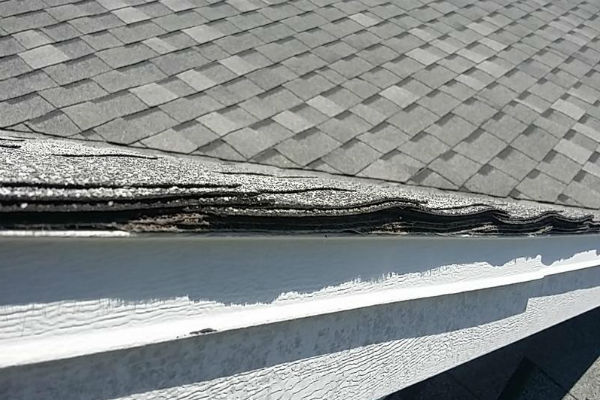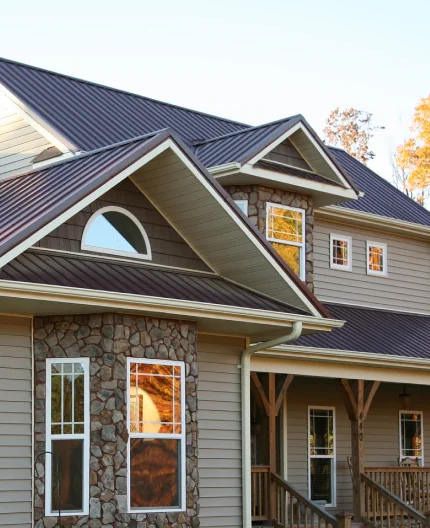A Homeowner’s Guide to Roof Inspection
Published on Tuesday November 15, 2016
You think you need a new roof. You call for a quote and some guys from the roofing company pay you a visit. They say they need to do a roof inspection. They go outside and walk around your house for a while.
What are they doing? What are they were looking for?
To the untrained eye, we admit this may seem confusing. That’s why we’ve compiled this list to let you know what our experts look for when they check out your roof.
Roofing inspection checklist
A roof inspector will look for missing or broken shingles, organic growth on the roof, ventilation problems, and any ripples, blisters, or buckles in shingles. This includes any other areas of wear and tear that may cause problems on the roof.
1. Missing or broken shingles
Asphalt shingles are found on 80% of residential roofs in the United States. As asphalt shingles age, they become brittle. A couple decades of direct sunlight and temperature extremes will do that! Brittle shingles can crack and break. Wind can tear off pieces. Whole shingles can even be torn off of the roof.
Note: When large parts of a shingles or entire shingles are blown off your roof, it can also be a sign of poor installation. Shingles that aren’t installed correctly are more likely to fail ahead of schedule.
To make matters worse, a bad install can void your warranty. Manufacturers know that a sloppy work causes shingles to deteriorate before their time.
In either case, once the shingles start to fly, a roof replacement may be in order to keep your roof deck intact and prevent more costly repairs down the road.
2. Moss, mildew or mold
Moss, mildew and mold create ugly patches on your roof. Your problem, however, goes beyond aesthetics: these growths are also damaging to the shingles and underlayment. They also don’t spring up overnight, so moss, mildew or mold can also be signs of an aging roof. During the roof inspection, our team keeps a close eye out for signs of these troublemakers.
All three need moisture to thrive, and all three hold that moisture. As moss, mildew and mold grow, they create raised masses that can hinder water runoff. Now even more moisture is trapped on the surface of your roof, which means more moss, mildew and mold can grow. It’s a vicious circle that can destroy your shingles!
3. Ventilation problems
Does your roof get enough air? Most people don’t realize that inadequate attic ventilation is one of a roof’s worst nightmares. Poor ventilation allows hot air from inside your home to heat the roof deck, which ages shingles by making them brittle, and can also cause curling.
For homes in regions with snow and ice, a poorly vented attic can cause ice dams in gutters. Ice dams can cause moisture to get underneath shingles where it can start to rot the roof deck.
During a roof inspection, our experts look for the presence of ridge vents, eave vents, exhaust vents and mechanical ventilation systems. These vents help air to flow through attic spaces, moving warm, moist air out while letting cool, dry air in.
If our roofing team suspects that you do not have sufficient ventilation, they will suggest options to get that air flowing.
4. Ripples, blisters or buckles
Ripples, blisters, buckles or physical changes can signal myriad roof problems. These can include:
- Very old shingles
- Inadequate ventilation
- Improper installation
- Damaged sheathing
- Multiple layers of shingles
- Wet underlayment
Shingles go through a natural aging process where some physical changes may begin to appear (just like wrinkles on our skin). When these changes become obvious from a roof inspection done on the ground, you may need a roof replacement.
An old and deteriorating roof means a vulnerable roof deck. A damaged roof deck makes for a very expensive roof replacement.
5. Multiple layers of shingles

If a home has multiple layers of shingles, odds are good that there is roof damage – even if you can’t see it yet. When a roof has more than one layer of shingles, the roof won’t ventilate properly. Heat and moisture can be retained beneath the shingles.
Another red flag: “telegraphing.” Telegraphing is described the the National Association of Certified Home Inspectors as “an issue when new roofs are installed over old. The new shingles can conform to the older shingles beneath them and follow any humps or low spots…As runoff flows down the roof, this unevenness can create areas of increased friction, which results in premature failure of the new roof over those areas.”
If you have any doubts, check out the warranty details on your asphalt shingles. Manufacturers almost always require a clean roof deck to respect the warranty on their product.
6. No drip edge
Drip edge is a type of flashing at the edges of your roof. Flashing, by the way, “helps direct the flow of water around openings…(and) can be made of sheet metal, plastic or composite materials.” Flashing is installed underneath the shingles as a way to protect the wooden fascia from water runoff (at the eaves) or wind-driven rain (at the rakes).
A roof without drip edge, or with improperly installed drip edge, may have rotten or rotting fascia because of penetrating water. If shingles at the edges of the roof are starting to curl, it could be due to moisture.
7. Interior leaks
If there are visible leaks inside your home, then roof repair or replacement is critical. An interior leak means that water has penetrated all roofing materials, and you can be sure that there is damage to the shingles and possibly the existing decking.
When a roof leak is not repaired, water has the opportunity to damage joists and trusses, meaning costly repairs beyond the cost of a roof replacement.
Action after the roof inspection
If you’ve noticed problems with any of these factors but haven’t called a roofer for a more detailed evaluation – it’s time to pick up the phone. Severely aged roofs often show more than one of these symptoms, and the clock may be ticking on the life of your roof deck.
Need a roof replacement? Give us a call.
If you need a roof replacement, we will work with you to put together a roofing package that you can live with – including our 50-year warranty. We bring trust and peace of mind to every Long Roofing roof. Contact Long Roofing online to get a price, schedule a free, in-home estimate or find answers to any home roofing questions.
Interested in Long Home Products?
See our special offers now.
*Excludes labor. Subject to credit approval.
**Excludes labor. Subject to credit approval.
One-day installs contingent upon municipal rules and regulations.
By submitting a form, I authorize Long Home to contact me with information about its products and services via mail, email, phone and/or text at the contact information provided, even if I am on the national do not call list. Long Home may use automated telephone technology to initiate calls to its customers. Calls and in person estimates may be recorded for quality and training purposes.








